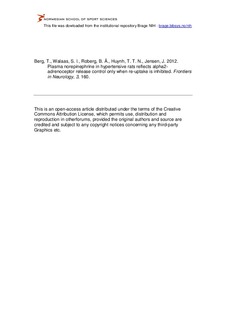| dc.contributor.author | Berg, Torill | |
| dc.contributor.author | Walaas, S. Ivar | |
| dc.contributor.author | Roberg, Bjørg Åse | |
| dc.contributor.author | Huynh, Trang Thi Ngoc | |
| dc.contributor.author | Jensen, Jørgen | |
| dc.date.accessioned | 2013-01-11T12:39:00Z | |
| dc.date.available | 2013-01-11T12:39:00Z | |
| dc.date.issued | 2012-11 | |
| dc.identifier | Seksjon for fysisk prestasjonsevne / Department of Physical Performance | |
| dc.identifier.citation | Frontiers in Neurology. 2012, 3, article 160 | no_NO |
| dc.identifier.issn | 1664-2295 | |
| dc.identifier.uri | http://hdl.handle.net/11250/170996 | |
| dc.description | Copyright:© 2012 Berg, Walaas, Roberg, Huynh and Jensen. This is an open-access article distributed under the terms of the Creative Commons Attribution License, which permits use, distribution and reproduction in other forums, provided the original authors and source are credited and subject to any copyright notices concerning any third-party graphics etc. | no_NO |
| dc.description.abstract | α2-adrenoceptors (AR) lower central sympathetic output and peripheral catecholamine release, thereby protecting against sympathetic hyperactivity and hypertension. Norepinephrine re-uptake–transporter effectively (NET) removes norepinephrine from the synapse. Overflow to plasma will therefore not reflect release. Here we tested if inhibition of re-uptake allowed presynaptic α2AR release control to be reflected as differences in norepinephrine overflow in anesthetized hypertensive spontaneously hypertensive rats (SHR) and normotensive rats (WKY). We also tested if α2AR modulated the experiment-induced epinephrine secretion, and a phenylephrine-induced, α1-adrenergic vasoconstriction. Blood pressure was recorded through a femoral artery catheter, and cardiac output by ascending aorta flow. After pre-treatment with NET inhibitor (desipramine), and/or α2AR antagonist (yohimbine, L-659,066) or agonist (clonidine, ST-91), we injected phenylephrine. Arterial blood was sampled 15 min later. Plasma catecholamine concentrations were not influenced by phenylephrine, and therefore reflected effects of pre-treatment. Desipramine and α2AR antagonist separately had little effect on norepinephrine overflow. Combined, they increased norepinephrine overflow, particularly in SHR. Clonidine, but not ST-91, reduced, and pertussis toxin increased norepinephrine overflow in SHR and epinephrine secretion in both strains. L-659,066 + clonidine (central α2AR-stimulation) normalized the high blood pressure, heart rate, and vascular tension in SHR. α2AR antagonists reduced phenylephrine-induced vasoconstriction equally in WKY and SHR. Conclusions: α2AAR inhibition increased norepinephrine overflow only when re-uptake was blocked, and then with particular efficacy in SHR, possibly due to their high sympathetic tone. α2AAR inhibited epinephrine secretion, particularly in SHR. α2AAR supported α1AR-induced vasoconstriction equally in the two strains. α2AR malfunctions were therefore not detected in SHR under this basal condition. | no_NO |
| dc.language.iso | eng | no_NO |
| dc.publisher | Frontiers Media S.A. | no_NO |
| dc.subject | α2-adrenoceptors | no_NO |
| dc.subject | norepinephrine re-uptake transporter | no_NO |
| dc.subject | hypertension | no_NO |
| dc.subject | sympathetic nervous system activity | no_NO |
| dc.subject | norepinephrine | no_NO |
| dc.subject | epinephrine | no_NO |
| dc.subject | catecholamine release | no_NO |
| dc.subject | catecholamine concentrations | no_NO |
| dc.title | Plasma norepinephrine in hypertensive rats reflects α2-adrenoceptor release control only when re-uptake is inhibited | no_NO |
| dc.type | Journal article | no_NO |
| dc.type | Peer reviewed | no_NO |
| dc.subject.nsi | VDP::Medical disciplines: 700::Clinical medical disciplines: 750::Neurology: 752 | no_NO |
| dc.source.pagenumber | Article 160 | no_NO |
| dc.source.volume | 3 | no_NO |
| dc.source.journal | Frontiers in Neurology | no_NO |
| dc.identifier.doi | 10.3389/fneur.2012.00160 | |
